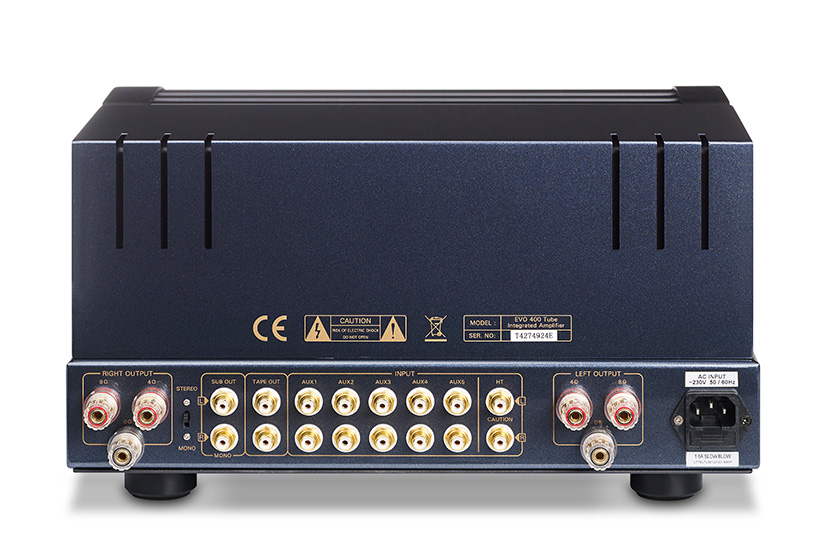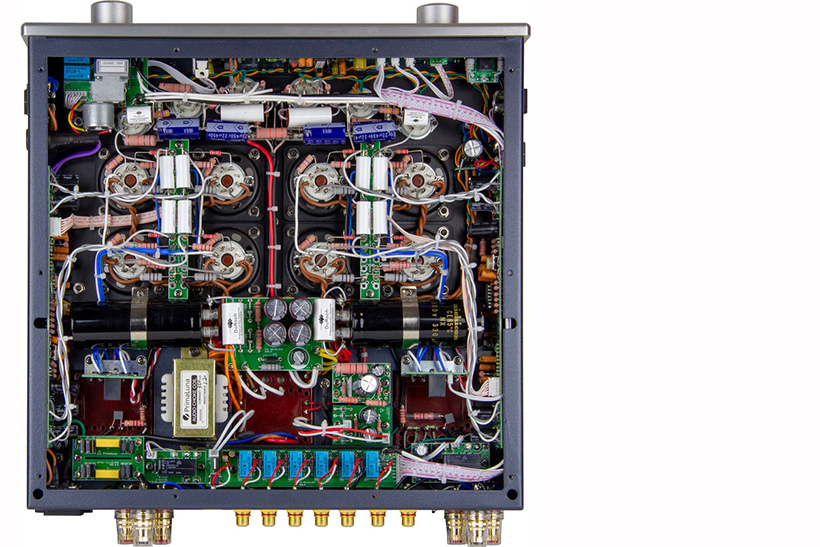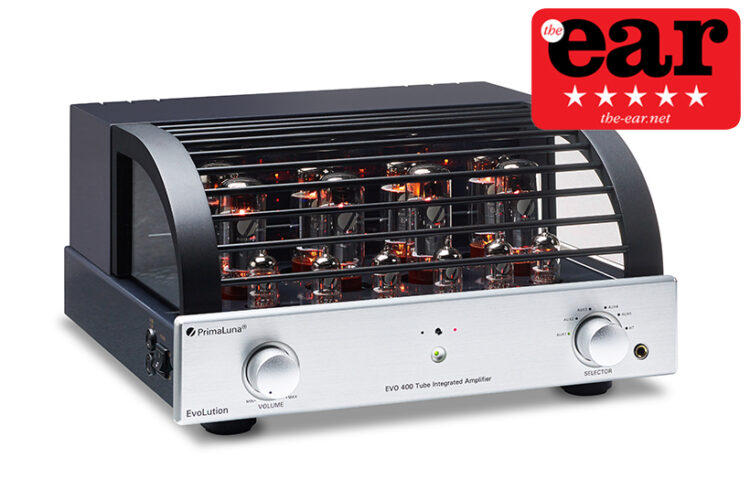Prior to the EVO 400 my Dutch colleague René van Es got in first when it came to Primaluna reviews in the past. Despite the Italian name, this company is from the Netherlands, and owner Herman van den Dungen is a major figure on the scene there. Having read his enthusiastic reviews of these valve amps, I thought it was about time I found out what all the fuss was about. There has to be some reason why Primaluna has such a strong position in the world of affordable valve electronics brands.
With the introduction of the Evolution range in 2019, Primaluna managed to clarify the products’ hierarchy. There are four Evolution levels from 100 to 400 with a preamp, a power amp and an integrated at each level. The only exception is the DAC of which there’s just the one EVO 100 model. Therefore, the Evolution 400 is the biggest amp that they make, and the integrated model is quite a beast, weighing in at 31 kilos thanks to some substantial metalwork in the mains and output transformers.
It is ostensibly an Ultra-Linear (push-pull) design with four EL34 valves per channel but has the unusual feature of offering triode operation at the press of a button on the rather nice metal remote handset. Therefore, you can choose a mode of operation that suits the music and the speakers on a whim, or for that matter, one that works with the headphones you plug in. This amp dedicates its output stage to driving the headphone socket, which is surprisingly rare and must be a little tricky. The Evolution 400 has a switch on the side to enable headphone drive, and another next to it marked high and low bias, which is a slightly confusingly named way of adjusting the bias for different types of valve. Low bias is for the EL34s that the amp is supplied with or an equivalent, while high bias suits a range of KT tubes, e.g. KT88 right up to KT150s that give the highest power output. Primaluna lists the wide variety of tubes that can be run on this amplifier on their site.

One reason they can offer this degree of flexibility is the adaptive autobias system that monitors bias continuously to enhance tube life and increase performance. You can even use unmatched tubes in this circuit because of this feature. There are five line inputs plus an AV bypass which means that the signal goes straight to the power amp stage, great for home cinema processors and external preamps, disastrous for full signal source components – handle with care. You can also get the Evolution 400 with a phono stage bolted underneath. This is for moving magnet cartridges only so MC users will need a step-up transformer, but that is a popular approach among tube aficionados. Primaluna is keen to point out that this isn’t an afterthought, but a well-shielded phono stage that had to be put on the outside of the box because there’s no space left within the chassis.
Power output varies with tube type and operational mode but with the EL34s supplied the Evolution 400 offers 70 watts per channel in Ultra-Linear mode and 38 watts in triode mode. There are 4 and 8 Ohm outputs for the speakers and which you choose will depend very much on the speakers, a lot of brands quote a nominal 8 Ohm impedance, but in reality, it can be much lower, so it’s a case of sucking and seeing.
Sound quality
With Bowers & Wilkins 802 D3 speakers on the other end of the cables, the 4 Ohm tap is the only game in town, these are not an easy load despite the 90dB sensitivity. I also needed to pull them away from the wall by 10cm to keep the bass under control, but that said the preceding amplifier (Moor Amps Angel 6) had seen them pushed closer to the wall. After downloading the manual, I discovered that the green light means triode operation and the red one Ultra-Linear (it would be useful if this was written next to the lights). Given that the EL34 was created for Ultra-Linear operation, that’s the way listening commenced. And highly entertaining it was too, as Primaluna points out the EL34 is one of the most musical tubes ever built and this comes through regardless of what you play. The fact that you have so many of them, most only have two per channel, means there’s more real power to play with so it’s possible to get decent volume levels without discomfort. The EVO 400 has a forgiving character that emphasises the quality of composition and musicianship regardless of music type, timing is particularly strong, and almost anything will provoke a physical response if your synapses are that way inclined. I found myself leaping about to a far greater degree than usual. My foot was rarely still. This quality is not so strong in triode mode where there is less drive and more openness albeit not enough to make this option appealing enough to persist with via the 802s at least.

The Evo 400 is impressively quiet for an all-tube amplifier, it can deliver an inky black background when necessary and is very good at delivering fine detail, the stuff that’s low in level but combines with the fundamentals to create a real sense of space in a recording. Presence is solid, there is a slight emphasis on the midrange which brings out voices and instruments in the same tonal range, but this is pretty subtle by tube standards. The bass is strong and controlled but has an easy flow to it that is very appealing, it makes me realise that I really should have bought that Leak Stereo 20 I saw at the Tonbridge audio jumble a couple of years back, but that wouldn’t drive the 802s beyond a whisper. Even the Primaluna has trouble extracting the full extent of the bass on Bob Marley’s Natural Mystic but none whatsoever in bringing an organic, relaxed version into your life, one that in all probability is closer to what the artist heard back in the day given the limitations of monitoring systems in the seventies. With the more up to date vibes of Bugge Wesseltoft and Prins Thomas’s Furuberget, it really makes the sound pop out of the system, fully formed in three dimensions, making a good case for the strides that have been made in the studio over the last four decades.
Being a sucker for punishment I decided to try the Primaluna with the PMC twenty5.26i speakers reviewed last November, shifting nearly 100 kilos of 802 twice isn’t easy, but the reward was worth it. The PMC has lower sensitivity (86dB) than the B&W but is presumably an easier load because the pairing produced a result that exceeded the sum of the parts, delivering better timing, a wide-open soundstage and a beguiling sound with both digital and analogue sources. This pairing can produce acres of reverb or an intimate portrait depending on the recording, and it takes the hardness out of more forward recordings without sacrificing definition. I tried the 4 and 8 Ohm output taps once more and came to the same conclusion as with the B&Ws, the 8 Ohm option is clearly brighter because the bass is not as powerful, I tried pushing them back to the wall, but that didn’t compensate and returning to the 4 Ohm option increased the thrill power noticeably.

Finally, I tried the headphone output, it’s not my bag so I don’t have any fancy headphones just a pair of Focal Spirits from back in the day. Initially, I played something through the output on an Auralic Vega G2.1 DAC before switching to the Evo 400, this improved the sense of life with a more open sound in Ultra-Linear mode, but when I turned on triode mode, I remembered why I have such fond memories of this approach. It gives an ease and transparency that is almost magical, and while it can’t be all that neutral, it is utterly enthralling, all you need is huge speakers, or headphones.
This is a very nice amplifier indeed, it combines the smooth transparency of tubes with enough power to drive speakers that wouldn’t work with most glass powered amps. I love that it’s is so flexible and fully-featured yet retains the huge musical advantage of Ultra-Linear operation, with triode mode available to those with speakers that can work with it. If you want features, detail and musical charm it’s a very strong offering indeed.


